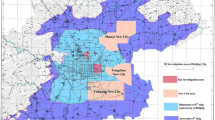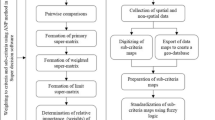Abstract
This article explores two different methods, vector re-classification and raster fuzzification, for choosing the best railway routes between Shiraz and Yazd in Iran using spatial information systems. The right use of these systems can have significant economic benefits for railways, allowing for better decision-making and more efficient resource allocation. Topography analysis in spatial information systems, including calculating the shortest and optimal route, is a practical and valuable application. The study used satellite images and Google Earth Engine to extract vector or raster maps for the cost-path algorithm. The results of the raster fuzzy approach suggested alternative A (111 km, slope 2%) and alternative B (115 km, slope 25%), while the vector reclassification approach showed alternative C (131 km, slope 28%). After employing semi and non-structure problem-solving, as well as profile and rout topographic analysis, path A was selected as the optimal route. The study concluded that the raster fuzzy approach was more effective in finding railway paths and could provide better results for decision-makers in similar projects.






Similar content being viewed by others
Data availability
Data are available when requested.
Code availability
(Yes GEE code: https://code.earthengine.google.com/053fbc3ab55214ce960718b27832cfa7).
References
Aliabad, F. A., Shojaei, S., Mortaz, M., Ferreira, C. S. S., & Kalantari, Z. (2022). Use of Landsat 8 and UAV images to assess changes in temperature and evapotranspiration by economic trees following foliar spraying with light-reflecting compounds. Remote Sensing, 14(23), 6153. https://doi.org/10.3390/rs14236153
Grassi, S., Friedli, R., Grangier, M., & Raubal, M. (2014). A GIS-based process for calculating visibility impact from buildings during transmission line routing. Connecting a digital europe through location and place (pp. 383–402). Springer. https://doi.org/10.1007/978-3-319-03611-3_22
Singh, M. P., & Singh, P. (2017). Multi-criteria GIS modeling for optimum route alignment planning in outer region of Allahabad City, India. Arabian Journal of Geosciences, 10(13), 294. https://doi.org/10.1007/s12517-017-3076-z
Mansourmoghaddam, M., Ghafarian Malamiri, H. R., Arabi Aliabad, F., Fallah Tafti, M., Haghani, M., & Shojaei, S. (2022). The separation of the unpaved roads and prioritization of paving these roads using UAV images. Air, Soil and Water Research, 15, 11786221221086284. https://doi.org/10.1177/11786221221086285
Konomi, S. I., & Roussos, G. (2007). Ubiquitous computing in the real world: Lessons learnt from large scale RFID deployments. Personal and Ubiquitous Computing, 11, 507–521. https://doi.org/10.1007/s00779-006-0116-1
Yildirim, V., & Bediroglu, S. (2019). A geographic information system-based model for economical and eco-friendly high-speed railway route determination using analytic hierarchy process and least-cost-path analysis. Expert Systems, 36(3), e12376. https://doi.org/10.1111/exsy.12376
Peng, J. J., Wang, J. Q., Zhang, H. Y., & Chen, X. H. (2014). An outranking approach for multi-criteria decision-making problems with simplified neutrosophic sets. Applied Soft Computing, 25, 336–346. https://doi.org/10.1016/j.asoc.2014.08.070
Aliabad, F. A., Malamiri, H. R. G., Shojaei, S., Sarsangi, A., Ferreira, C. S. S., & Kalantari, Z. (2022). Investigating the ability to identify new constructions in urban areas using images from unmanned aerial vehicles, google earth, and Sentinel-2. Remote Sensing, 14(13), 3227. https://doi.org/10.3390/rs14133227
He, S., Wang, D., Zhao, P., Li, Y., Lan, H., Chen, W., & Jamali, A. A. (2020). A review and prospects of debris flow waste-shoal land use in typical debris flow areas. China. Land Use Policy, 99, 105064. https://doi.org/10.1016/j.landusepol.2020.105064
Pennington, D. N., Hansel, J. R., & Gorchov, D. L. (2010). Urbanization and riparian forest woody communities: Diversity, composition, and structure within a metropolitan landscape. Biological Conservation, 143(1), 182–194. https://doi.org/10.1016/j.biocon.2009.10.002
Awange, J. L., & Kiema, J. B. K. (2013). Spatial analysis. Environmental geoinformatics (pp. 225–236). Springer. https://doi.org/10.1007/978-3-642-34085-7_17
Taillefumier, F., & Piégay, H. (2003). Contemporary land use changes in prealpine Mediterranean mountains: A multivariate GIS-based approach applied to two municipalities in the Southern French Prealps. CATENA, 51(3–4), 267–296. https://doi.org/10.1016/S0341-8162(02)00168-6
Qanbari, V., & Jamali, A. A. (2015). The relationship between elevation, soil properties and vegetation cover in the Shorb-Ol-Ain watershed of Yazd. Journal of Biodiversity and Environmental Science (JBES) 49–56.
Andersen, J. L. E., & Landex, A. (2010). Alignment analysis of urban railways based on passenger travel demand. In 12th International Conference on Computer System Design and Operation in the Railway and other Transit Systems (pp. 337–348). WIT Press. https://doi.org/10.2495/CR100321
Jamali, A. A., Tabatabaee, R., & Randhir, T. O. (2021). Ecotourism and socioeconomic strategies for Khansar River watershed of Iran. Environment, Development and Sustainability. https://doi.org/10.1007/s10668-021-01334-y
Raeisi, R., Dincă, I., Almodaresi, S. A., Swart, M. P., & Boloor, A. (2022). An assessment of geosites and geomorphosites in the Lut Desert of Shahdad Region for potential geotourism development. Land, 11(5), 736. https://doi.org/10.3390/land11050736
De Luca, M., Dell’Acqua, G., & Lamberti, R. (2012). High-speed rail track design using GIS and multi-criteria analysis. Procedia-Social and Behavioral Sciences, 54, 608–617. https://doi.org/10.1016/j.sbspro.2012.09.778
Yang, N., Kang, M. W., Schonfeld, P., & Jha, M. K. (2014). Multi-objective highway alignment optimization incorporating preference information. Transportation Research Part C: Emerging Technologies, 40, 36–48. https://doi.org/10.1016/j.trc.2013.12.010
Jamali, A. A., & Abdolkhani, A. (2009). Preparedness against landslide disasters with mapping of landslide potential by GIS-SMCE (Yazd-Iran). International Journal of Geoinformatics, 5(4), 25–31.
Saaty, T. L. (1988). What is the analytic hierarchy process? Mathematical models for decision support (pp. 109–121). Springer. https://doi.org/10.1007/978-3-642-83555-1_5
Malczewski, J. (1999). GIS and multicriteria decision analysis. John Wiley & Sons.
Saaty, T. L. (2008). Decision making with the analytic hierarchy process. International Journal of Services Sciences, 1(1), 83–98. https://doi.org/10.1504/IJSSCI.2008.017590
Effat, H. A., & Hassan, O. A. (2013). Designing and evaluation of three alternatives highway routes using the Analytical Hierarchy Process and the least-cost path analysis, application in Sinai Peninsula, Egypt. The Egyptian Journal of Remote Sensing and Space Science, 16(2), 141–151. https://doi.org/10.1016/j.ejrs.2013.08.001
Castro, M., Anta, J. A., Iglesias, L., & Sánchez, J. A. (2014). GIS-based system for sight distance analysis of highways. Journal of Computing in Civil Engineering, 28(3), 04014005. https://doi.org/10.1061/(ASCE)CP.1943-5487.0000317
Kim, H. Y., Wunneburger, D., Neuman, M., & An, S. Y. (2014). Optimizing high-speed rail routes using a Spatial Decision Support System (SDSS): The Texas Urban Triangle (TUT) case. Journal of Transport Geography, 34, 194–201. https://doi.org/10.1016/j.jtrangeo.2013.11.014
Kouli, M., Loupasakis, C., Soupios, P., Rozos, D., & Vallianatos, F. (2014). Landslide susceptibility mapping by comparing the WLC and WofE multi-criteria methods in the West Crete Island, Greece. Environmental Earth Sciences, 72(12), 5197–5219. https://doi.org/10.1007/s12665-014-3389-0
Choi, Y., Park, H. D., Sunwoo, C., & Clarke, K. C. (2009). Multi-criteria evaluation and least-cost path analysis for optimal haulage routing of dump trucks in large scale open-pit mines. International Journal of Geographical Information Science, 23(12), 1541–1567. https://doi.org/10.1080/13658810802385245
Durmaz, A. İ, Ünal, E. Ö., & Aydın, C. C. (2019). Automatic pipeline route design with multi-criteria evaluation based on least-cost path analysis and line-based cartographic simplification: A case study of the Mus project in Turkey. ISPRS International Journal of Geo-Information, 8(4), 173. https://doi.org/10.3390/ijgi8040173
Census I.R.I. (2018). Selected Findings of the 2016 National Population and Housing Census.
UNESCO. (2018). Historical City of Yazd Inscribed as World Heritage Site. Retrieved 1 Jan 2018.
Jamali, A. A., Zarekia, S., & Randhir, T. O. (2018). Risk assessment of sand dune disaster in relation to geomorphic properties and vulnerability in the Saduq-Yazd Erg. Applied Ecology and Environmental Research, 16, 579–590. https://doi.org/10.15666/aeer/1601_579590
Shiraz Climate Normals. (2015). 1961–1990 National Oceanic and Atmospheric Administration. Retrieved 7 Apr 2015.
Ghane Ezabadi, N., Azhdar, S., & Jamali, A. A. (2021). Analysis of dust changes using satellite images in Giovanni NASA and Sentinel in Google Earth Engine in western Iran. Journal of Nature and Spatial Sciences (JONASS), 1(1), 17–26. https://doi.org/10.30495/jonass.2021.680327
Carrasco, L., O’Neil, A. W., Morton, R. D., & Rowland, C. S. (2019). Evaluating combinations of temporally aggregated Sentinel-1, Sentinel-2 and Landsat 8 for land cover mapping with Google Earth Engine. Remote Sensing, 11(3), 288. https://doi.org/10.3390/rs11030288
Cao, Z., Wang, W., Ma, D., Su, J., Gao, Z., & Han, Y. (2009). Optimum path analysis of post-earthquake transportation considering multi-objective based on GIS. In International Conference on Transportation Engineering 2009 (pp. 1104–1109). https://doi.org/10.1061/41039(345)183
Kang, M. W., Jha, M. K., & Schonfeld, P. (2012). Applicability of highway alignment optimization models. Transportation Research Part C Emerging Technologies, 21(1), 257–286. https://doi.org/10.1016/j.trc.2011.09.006
Parsasyrat, L., & Jamali, A. A. (2015). The effects of impermeable surfaces on the flooding possibility in Zarrin-Shahr, Isfahan Municipal Watershed. Journal of Applied Environmental and Biological Sciences, 5(1), 28–38.
Masoumi, H., Jamali, A. A., & Khabazi, M. (2014). Investigation of role of slope, aspect and geological formations of landslide occurrence using statistical methods and GIS in some watersheds in Chahar Mahal and Bakhtiari Province. Journal of Applied Environmental and Biological Sciences, 4(9), 121–129.
He, S., Wang, D., Li, Y., Zhao, P., Lan, H., Chen, W., Jamali, A. A., & Chen, X. (2021). Social-ecological system resilience of debris flow alluvial fans in the Awang basin, China. Journal of Environmental Management, 286, 112230. https://doi.org/10.1016/j.jenvman.2021.112230
https://www.gisagmaps.com/landsat-8-sentinel-2-bands/. Accessed 15 Nov 2021.
Jamali, A. A., & Ghorbani Kalkhajeh, R. (2020). Spatial modeling considering valley’s shape and rural satisfaction in check dams site selection and water harvesting in the watershed. Water Resources Management, 34(10), 3331–3344. https://doi.org/10.1007/s11269-020-02616-2
Taleai, M., & Yameqani, A. S. (2018). Integration of GIS, remote sensing and multi-criteria evaluation tools in the search for healthy walking paths. KSCE Journal of Civil Engineering, 22(1), 279–291. https://doi.org/10.1007/s12205-017-2538-x
Fagan, J. (2019). Nursing clinical brain. OER Commons. Available on: https://oercommons.org/authoring/53029-nursing-clinical-brain/view.
Funding
Private funding by authors.
Author information
Authors and Affiliations
Contributions
AAJ: Conceptualization, Methodology, Investigation, Validation, Resources, Data Curation, Software, Writing-Review & Editing, Supervision, and Project administration. AE: Conceptualization, Methodology, Investigation, Formal analysis, Resources, Data Curation, and Software. SM: Conceptualization, Methodology, Investigation, Formal analysis, Resources, Data Curation, and Software. SH: Methodology, Investigation, Resources, Data, and Software).
Corresponding author
Ethics declarations
Conflict of interest
The authors declares that they have no conflict of interest.
Additional information
Publisher's Note
Springer Nature remains neutral with regard to jurisdictional claims in published maps and institutional affiliations.
Rights and permissions
Springer Nature or its licensor (e.g. a society or other partner) holds exclusive rights to this article under a publishing agreement with the author(s) or other rightsholder(s); author self-archiving of the accepted manuscript version of this article is solely governed by the terms of such publishing agreement and applicable law.
About this article
Cite this article
Jamali, A.A., Esmailian, A., Mokhtarisabet, S. et al. Path selection by topographic analysis: vector re-classification versus raster fuzzification as spatial multi-criteria using cost-path. Spat. Inf. Res. 31, 709–719 (2023). https://doi.org/10.1007/s41324-023-00539-9
Received:
Revised:
Accepted:
Published:
Issue Date:
DOI: https://doi.org/10.1007/s41324-023-00539-9




